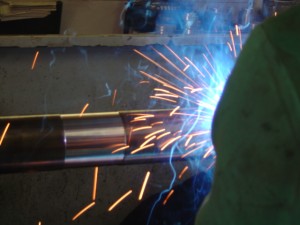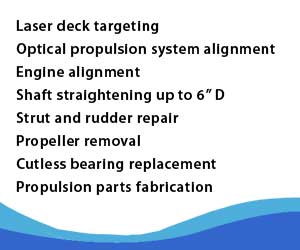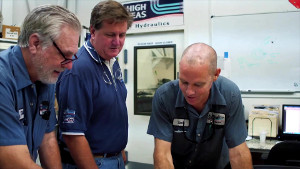
- Cladding or Weld-over on Aquamet shafts
From time-to-time we come across shafts that have suffered from a bad case of crevice corrosion. Crevice corrosion, unlike galvanic corrosion, comes from stagnant water that changes chemical composition with time. We find crevice corrosion on shafts in the seal area, bearing area and inside the stern tube. Usually the crevice corrosion is not found on the part of the shaft exposed under the boat since tidal flow keeps the water moving and “fresh”. Wiki has more explanation here.
Crevice corrosion on the shaft in non-bearing or seal areas are OK and usually left alone. However, if the corrosion is in a cutlass bearing location or seal/packing area it must be repaired. The pitting will cut up a new cutlass bearing in a short time and will not let a shaft seal properly seat and keep dry.
To repair the area, as we are doing on this 87′ Oceanfast, requires machining down the shaft (as seen to the left of the machinist shoulder) and then filling in the area with a welding bead. This is called a
weld-over or cladding (more pics here). In this picture there were two different areas requiring repair. The area pictured is right under a half cutlass bearing. The welded area is a smaller section where the Tides seal will run.
Once the weld is complete the shaft will require straightening (600 degree welding will bend the shaft regardless of precautions), then a final machine and polishing. I challenge someone to come to the shop and find the weld when finished – it blends in that well.



 Click to watch the video of a day at High Seas Yacht Service.
Click to watch the video of a day at High Seas Yacht Service. Click to watch Marine Industries Association of South Florida video featuring Salty Jobs at High Seas Services.
Click to watch Marine Industries Association of South Florida video featuring Salty Jobs at High Seas Services.